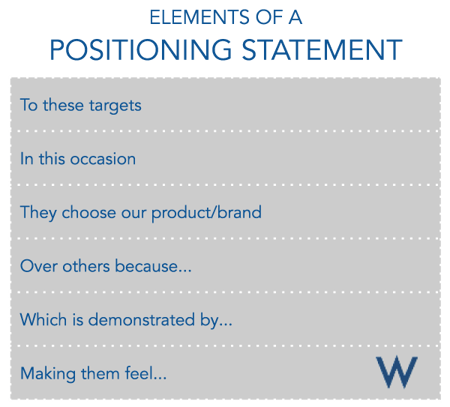No one wants to waste time with a product or service that isn’t right for them. Getting to the point of who you are and what you do is essential to effective messaging and meeting sales goals. Being clear in your marketing position statement upfront will answer that and inform any content creation for inbound marketing success.
How will you know what kinds of content to develop if you haven’t positioned yourself properly? Great content attracts the highest quality traffic, holds greater credibility with Google and other search engines, and helps build relationships.
To produce content that performs, you need a well-crafted, thoughtful positioning statement that has at its core a deep understanding of target personas and their most pressing pain points.
What is a Marketing Positioning Statement and Why is it Important for Inbound Success?
What’s your positioning in the marketplace? Where do you stand? Are you most reliable? Fastest? Most accurate?
Think of Bounty paper towels and their “quicker picker-upper” philosophy. Maybe they aren’t the cheapest and, therefore, won’t market themselves as such; but they know where they stand with their product. The same concept applies to industrials — figure out your value proposition and then use that position to inform your marketing content and overall inbound strategy.
However, a marketing positioning statement isn’t just a catchy slogan or ad copy. An effective positioning statement defines your ideal customer, pinpoints what you will represent or mean to them, and supports that claim with facts.
While this approach will work for any business with a value proposition that’s meaningful to their target, we want to talk about the complex manufacturing industry in particular, since this is where much of our experience lies.
Keys for Determining Your True Value Proposition
If you’re marketing for a manufacturing company and need to create a positioning statement that results in inbound success, you must uncover some nuggets of truth about what the business’s purpose is as well as why it’s successful.
You’ll achieve this by interviewing the workers who have their boots on the ground as well as those who interact with customers frequently. Why do they believe customers choose you?
It’s best not to directly ask, “What are your strengths as a company?” Our experience tells us that about 80% of the time people will answer that question with “our people” or “quality” — which we refer to as motherhood and apple pie.
That’s all well and good, but that doesn’t put us any closer to a meaningful value proposition. Imagine how the press would react if Green Bay Packers head coach Matt LaFleur was asked the keys to last week’s win, and he answered, “It’s because of our people.”
No argument there, Coach; you have great people, but what exactly did they do? And how did they do it? What resulted in your team scoring more points than your opponent in the 60 minutes of action we’re focusing on right now? A good reporter interrogates for the deeper truths, because that’s where valuable knowledge hides.
We take the same approach with internal client interviews. Instead of generalizations and platitudes, we want to know what specifically leads to important customers making “buy” decisions with our clients.
- What were the difference makers?
- How did they evaluate your company pre-purchase?
- What were the things they seemed most pleased with?
- What aspects of doing business provided pleasant surprises to customers?
- Most importantly, what are the things they’d tell a friend about you?
This type of questioning that forces people to think about the distinct ingredients of success is where the best insights come from.
Sales people, in particular, develop wonderful insights about where their best value proposition resides; we help them uncover these insights by asking them about the kinds of customer needs they discover that instantly tell them a prospect is a perfect fit for their products and services.
RELATED: 5 Tips for Building a Better Manufacturing Sales Proposal
How to Craft an Effective Positioning Statement
Think of a positioning statement as a direct message to your prospects. Take what you learned from your employee and customer feedback and combine it with your business goals to create a statement that will let them know what you’re about.
What Should be Included in a Strong Positioning Statement?
Answer these questions with your positioning statement:
- Who’s your most important target? Focusing intelligently on the best target allows you to concentrate on being the most relevant to them.
- What’s your frame of reference? Are you competing with companies that make similar equipment, or are you competing as a progressive alternative to a mainstream approach? Use a frame of reference that best illustrates the net benefits you can deliver.
- What’s your primary promise? Write this as a benefit to your target. Knowing the meaningful intersections between your best target customer’s pain points and your demonstrated points of competitive advantage gives you relevance.
- Where’s your proof? Validate your promise with evidence. Here’s where case studies, white papers, third-party evaluations, customer payback analysis, and anything else you can imagine come into play.
 Example of a Positioning Statement for an Industrial Manufacturer
Example of a Positioning Statement for an Industrial Manufacturer
Remember the ingredients:
- Define your best prospects and figure out your most important targets (“To”).
- Pinpoint what your product or service will mean to those prospects and your promise to them (“Our product will”).
- Support that claim with evidence (“based on”).
Let’s look at an example of a positioning statement for a hypothetical industrial manufacturer that makes conveyor systems for paper products.
“To disposable paper/tissue manufacturers looking for conveyor equipment that increases throughput and easily integrates with existing system equipment, XYZ product will be the conveyor solution that has the greatest breadth of customization possibilities and is designed to be the easiest to connect with existing systems; the evidence for this position is our extensive engineering capabilities and experience successfully integrating with more than (X amount of) different system types.”
A strong, well-reasoned positioning will help you determine the topics you’ll write about and the types of messages that should be part of your content. Once your content team comes together around a well-considered, thoughtful, and disciplined positioning, you’ll see where you can point your content efforts.
Understand the Buyer’s Journey for Effective Inbound Marketing
Understanding your prospects and customers is vital in every part of inbound marketing. If you’ve already created the right buyer personas for your prospects, now is the time to see their journey through the buying process.
We’ve developed a free Buyer’s Journey Worksheet & Template to help guide you along the way. Click the link below and download your copy today!
Source link



 Example of a Positioning Statement for an Industrial Manufacturer
Example of a Positioning Statement for an Industrial Manufacturer